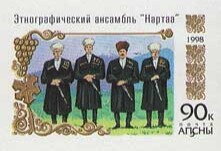Stamp: Ethnographic Ensemble "Nartaa" (Abkhazia 1998)
Ethnographic Ensemble "Nartaa" (Abkhazia 1998)
02 October (Abkhazia ) within release National Musical Collectives of Abkhazia goes into circulation Stamp Ethnographic Ensemble "Nartaa" face value 90 Russian kopek
| Stamp Ethnographic Ensemble "Nartaa" in catalogues | |
|---|---|
| Michel: | Mi: AB 257B |
Stamp is horizontal format.
Issued in sheet of 15 stamps + 1 label (4x4). Stamp number in Catalog of Republic of Abkhazia: 279 The "Nartaa" ensemble is an ethnographic dance group based in the city of Sukhumi, Republic of Abkhazia. The ensemble was founded in 1948 and is considered one of the oldest and most authoritative ensembles in the region. Their repertoire includes traditional Abkhazian folk dances performed in colorful costumes and to music played on traditional musical instruments. The "Nartaa" ensemble participates in numerous festivals and competitions both in Abkhazia and beyond, and is one of the brightest representatives of Abkhazian culture.Also in the issue National Musical Collectives of Abkhazia:
- Stamp - Dance Ensemble of Abkhazia "Sharatyn" face value 90;
- Stamp - Ensemble of Folk Dance "Kavkaz" face value 90;
- Stamp - Ethnographic Ensemble "Nartaa" face value 90;
Stamp Ethnographic Ensemble "Nartaa" it reflects the thematic directions:
Dance is an art form, often classified as a sport, consisting of sequences of body movements with aesthetic and often symbolic value, either improvised or purposefully selected. Dance can be categorized and described by its choreography, by its repertoire of movements or by its historical period or place of origin. Dance is typically performed with musical accompaniment, and sometimes with the dancer simultaneously using a musical instrument themselves.
Music is an art form and cultural activity whose medium is sound organized in time. The common elements of music are pitch (which governs melody and harmony), rhythm (and its associated concepts tempo, meter, and articulation), dynamics (loudness and softness), and the sonic qualities of timbre and texture (which are sometimes termed the "color" of a musical sound). Different styles or types of music may emphasize, de-emphasize or omit some of these elements. Music is performed with a vast range of instruments and vocal techniques ranging from singing to rapping; there are solely instrumental pieces, solely vocal pieces (such as songs without instrumental accompaniment) and pieces that combine singing and instruments. The word derives from Greek μουσική (mousike; "art of the Muses"). In its most general form, the activities describing music as an art form or cultural activity include the creation of works of music (songs, tunes, symphonies, and so on), the criticism of music, the study of the history of music, and the aesthetic examination of music. Ancient Greek and Indian philosophers defined music as tones ordered horizontally as melodies and vertically as harmonies. Common sayings such as "the harmony of the spheres" and "it is music to my ears" point to the notion that music is often ordered and pleasant to listen to.


